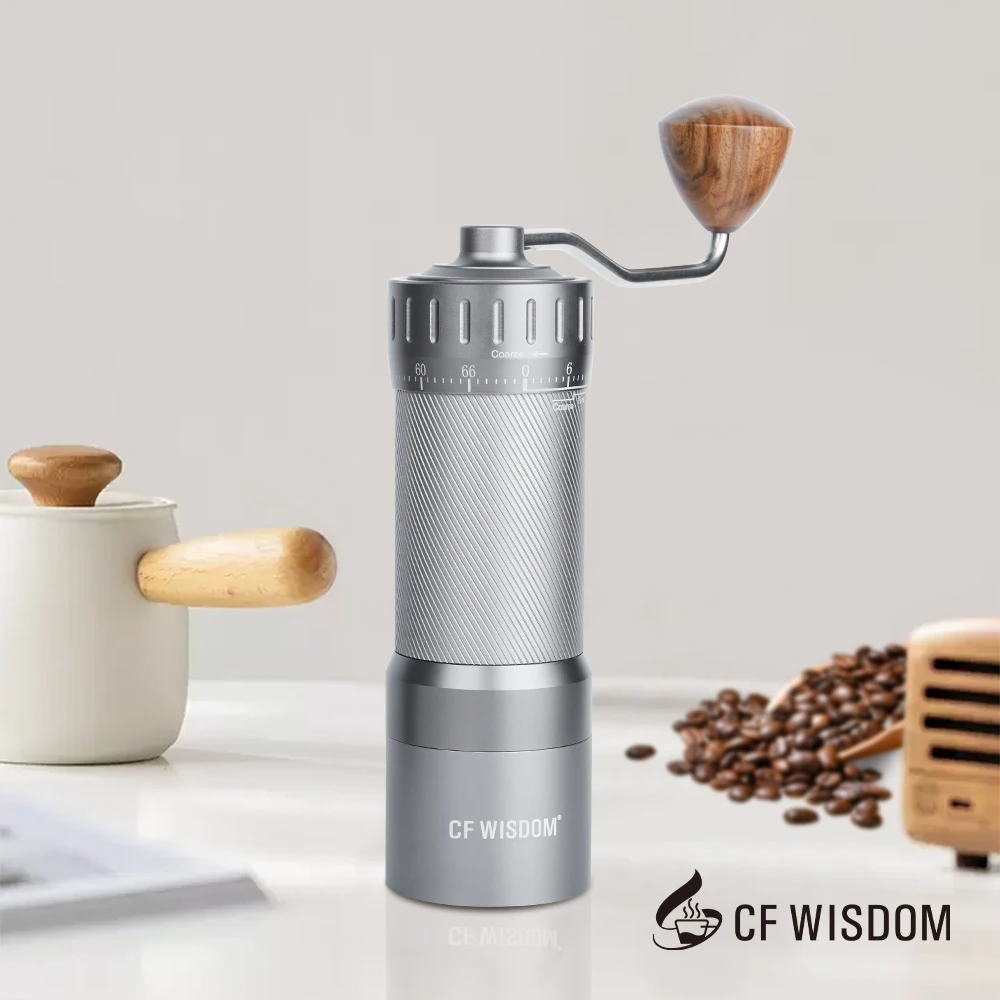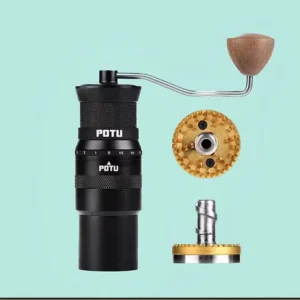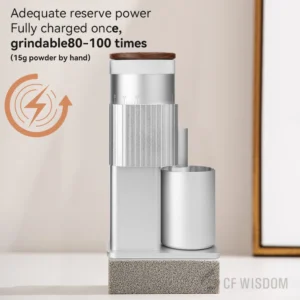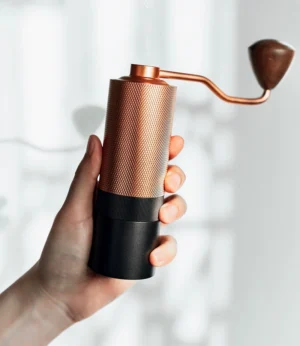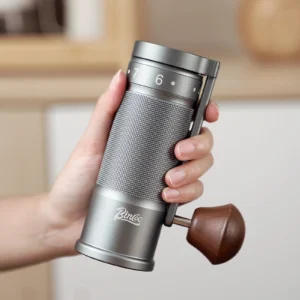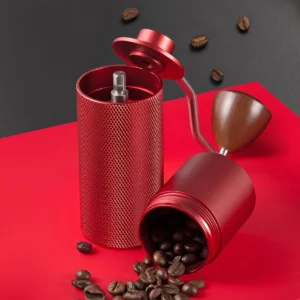The Science Behind Espresso Grind Size
Creating the perfect espresso shot requires understanding the precise science behind grind size. For manual espresso machines, the ideal grind is remarkably fine—approximately 200-400 microns, similar in texture to fine table salt or powdered sugar. This specific size is not arbitrary but based on fundamental extraction physics.
When hot water meets coffee grounds under pressure, three key factors interact: pressure, contact time, and surface area. Manual espresso machines typically operate at around 9 bars of pressure, forcing water through a compact puck of coffee. The grind size directly determines the resistance the water encounters, which affects flow rate and extraction time.
Unlike automated systems, manual machines give you direct control over the pressure applied. This hands-on approach means the grind size becomes even more critical—it must create just enough resistance to allow for the ideal extraction time of 25-30 seconds while maintaining proper flow.
The magic of espresso extraction happens in this delicate balance. Too coarse a grind creates too little resistance, resulting in water rushing through too quickly. Too fine, and the excessive resistance can cause channeling (water finding paths of least resistance) or completely choke the machine. Proper espresso grind settings create just enough resistance to allow water contact time of approximately 25-30 seconds for a standard 1:2 ratio shot (such as 18g of coffee yielding 36g of espresso).
This extraction window is critical—the majority of desirable compounds extract within this timeframe, giving espresso its characteristic intensity, sweetness, and complexity. The 30-second espresso rule exists because beyond this point, undesirable bitter compounds begin to dominate, while less time results in sour, underdeveloped flavors.
Understanding these fundamentals sets the foundation for all aspects of manual espresso preparation, from equipment selection to troubleshooting.
Identifying the Perfect Espresso Grind Texture
Knowing what the ideal espresso grind looks and feels like provides practical benchmarks to aim for when preparing your coffee. Visual assessment is your first indicator of proper grind size. The perfect espresso grind resembles fine, granular powder with a uniform appearance—not quite as fine as flour but significantly finer than table salt.
When you touch properly ground espresso coffee, it should feel silky between your fingers with a slight grittiness. When you pinch a small amount between your fingers and thumb, it should form small, delicate peaks rather than clumping into a solid mass (too fine) or falling apart completely (too coarse).
Another telltale sign of appropriate espresso grind is its tendency to form small clumps naturally. This “clumping behavior” indicates you’ve reached the fineness needed for proper extraction, though excessive clumping may signal the grind is too fine.
The uniformity of your grind is equally important as its size. When examining the grounds, you should see consistent particle sizes throughout. Inconsistency in grind texture is particularly problematic for manual machines, as larger particles create channels for water to pass through too quickly, while overly fine particles may block flow entirely.
Mastering espresso grind texture takes practice and attention to detail. A helpful comparison is to imagine the texture falling between powdered sugar and fine beach sand. This sensory approach complements the technical measurements, giving you practical ways to evaluate your grinding results without specialized equipment.
The Direct Impact of Grind Size on Extraction Quality
The relationship between grind size and extraction quality is direct and unmistakable, especially with manual espresso machines. Every aspect of your coffee’s flavor comes down to how effectively compounds are extracted from the grounds, and grind size is the primary variable controlling this process.
When your grind is too coarse for espresso, water flows through the coffee puck too quickly, resulting in under-extraction. This rapid flow means water doesn’t have sufficient time to dissolve the full range of desirable compounds. The resulting shot will appear pale with a thin, weak body and display characteristic under-extraction flavors: sour, sharp, and lacking sweetness. Under-extracted espresso often tastes one-dimensional and disappointingly thin, typically extracting only 14-17% of the coffee’s soluble compounds.
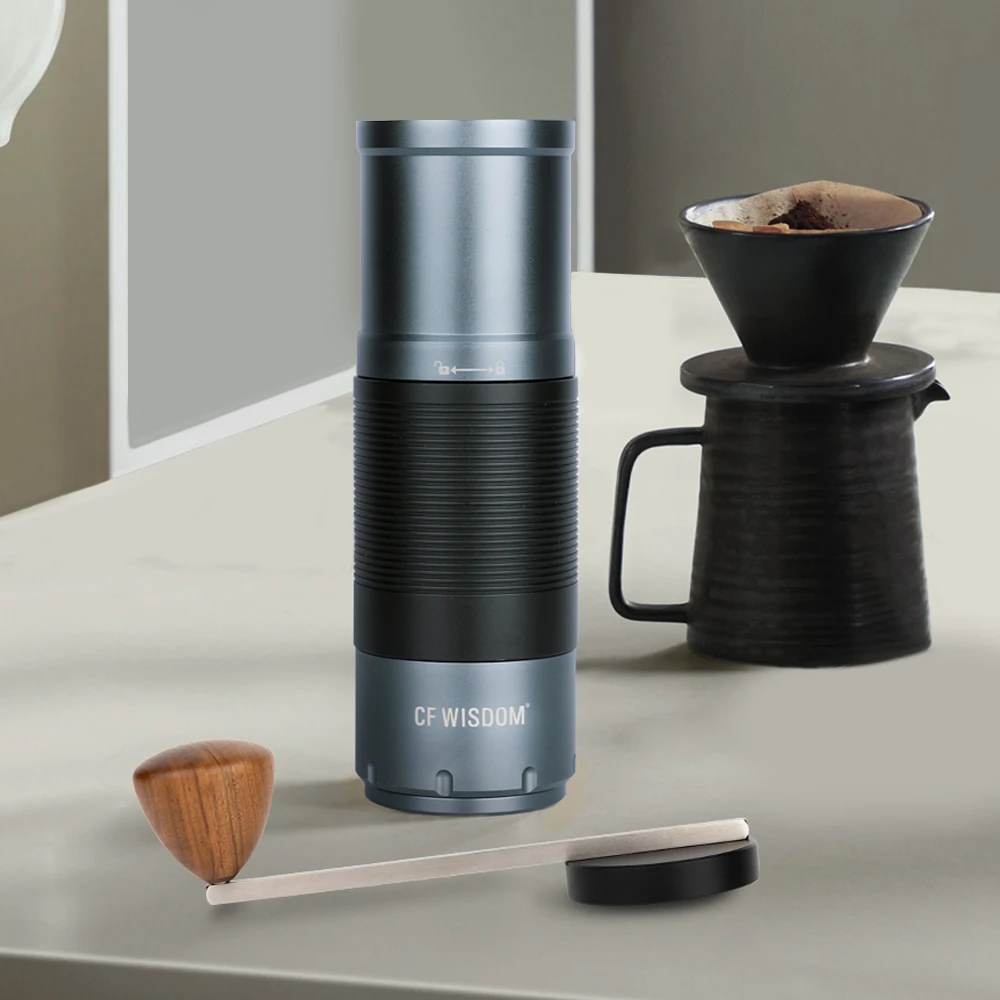
Conversely, an overly fine grind creates too much resistance, leading to over-extraction. Water struggles to pass through the puck, extending contact time beyond the ideal range. This excessive contact dissolves undesirable bitter compounds, resulting in espresso that tastes harsh, astringent, and unpleasantly bitter. Over-extracted espresso typically pulls beyond the optimal 25-30 second window and extracts more than 22-23% of the coffee’s soluble content.
The target extraction percentage for well-balanced espresso falls between 18-22% of the coffee’s mass. This narrow window is why correct grind setting for espresso requires such precision and often necessitates small, incremental adjustments.
When diagnosing extraction problems, your taste buds are your most valuable tool. Sourness typically indicates under-extraction requiring a finer grind, while pronounced bitterness suggests over-extraction requiring a coarser grind. Mastering perfect espresso means learning to make these adjustments with confidence, understanding that even tiny changes in grind size can dramatically affect the final result in your cup.
Essential Equipment for Precise Manual Espresso Grinding
Creating exceptional manual espresso starts with the right equipment. The cornerstone of your setup should be a high-quality burr grinder specifically capable of espresso-fine grinding. Unlike blade grinders that chop beans inconsistently, burr grinders crush beans between two surfaces (either flat or conical) to produce uniform particle sizes crucial for even extraction.
For manual espresso preparation, you’ll need:
Quality burr grinder: The most essential tool, ideally with fine adjustment capabilities and consistent output. Our manual espresso grinder collection features options specifically designed for the demands of espresso.
Precision scale: Measuring to 0.1g accuracy ensures consistency in both dosing and yield, allowing you to maintain the proper coffee-to-water ratio crucial for repeatable results.
Distribution tool: Helps achieve even density throughout the coffee puck, preventing channeling during extraction.
Tamper: Creates the necessary compression for proper extraction resistance.
Shot timer: Essential for monitoring extraction time to stay within the optimal 25-30 second window.
The difference between adequate and exceptional espresso often comes down to equipment quality. Comparing burr and blade grinders reveals why burr grinders are non-negotiable for espresso—they produce significantly more uniform particles, preventing the extraction inconsistencies that plague blade-ground coffee.
When selecting a manual grinder, consider factors like burr material (hardened steel or ceramic), burr size (larger burrs typically grind more efficiently), adjustment precision (more settings allow finer tuning), and build quality (ensuring alignment stability over time). These factors directly impact grinding consistency, which translates to extraction predictability in your cup.
While quality equipment requires investment, it eliminates many variables that can undermine your espresso results, creating a solid foundation for developing your manual brewing skills.
Step-by-Step: Dialing In Your Manual Espresso Grind
Achieving the perfect espresso grind requires a methodical approach known as “dialing in.” This process helps you systematically find the optimal grind setting for your specific beans, machine, and taste preferences.
Start with a baseline setting: Begin at the fine end of your grinder’s espresso range. With new beans, this gives you a starting point that you can adjust from.
Prepare your dose: Weigh out a consistent amount of coffee (typically 16-20g for a double shot), ensuring you use the same dose throughout the dialing-in process.
Pull a test shot: Grind your coffee, distribute evenly in the portafilter, tamp with consistent pressure (about 30 pounds), and extract while timing the shot.
Evaluate the extraction: Aim for a 1:2 ratio (e.g., 18g coffee yielding 36g espresso) within 25-30 seconds. Note the timing and observe the flow—it should resemble warm honey in consistency.
Taste and assess: Evaluate the flavor profile. Sourness indicates under-extraction (grind finer), while bitterness suggests over-extraction (grind coarser).
Make precise adjustments: Change only one variable at a time—start with grind size. Make small, incremental adjustments based on your results.
Document your findings: Record your settings, extraction times, and tasting notes for future reference.
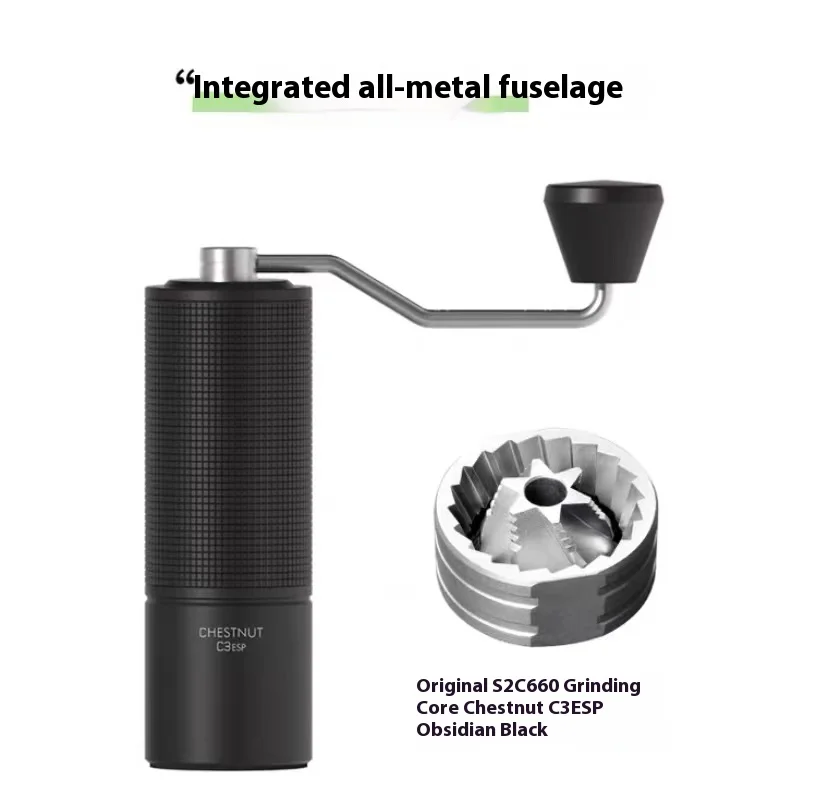
Finding the perfect grind setting for espresso often takes several attempts. When making adjustments, remember that finer grinds increase extraction time while coarser grinds decrease it. The visual appearance of your shot provides valuable feedback—a well-extracted shot will have a rich, tiger-striped appearance with a reddish-brown crema.
Quality precision manual grinders offer the fine adjustment capabilities necessary for this process. Look for grinders with numerous setting increments, as espresso often requires adjustments smaller than you might expect—sometimes just a quarter turn can make the difference between under and over-extraction.
This methodical approach eliminates guesswork and helps you develop consistency in your espresso preparation. With practice, you’ll become more efficient at dialing in, requiring fewer test shots to achieve optimal results.
Troubleshooting Common Grind-Related Extraction Problems
Even with careful preparation, espresso extraction issues can arise. Understanding how to diagnose and resolve these problems will significantly improve your manual espresso experience.
Channeling Problems
When water finds paths of least resistance through your coffee puck, it creates channels that result in uneven extraction. Signs include spraying or uneven flow from the portafilter spouts and holes in the used puck.
Solution: Ensure even distribution before tamping, consider using a distribution tool, and check for consistent grind size. Sometimes a slightly coarser grind can reduce channeling caused by excessive fine particles.
Inconsistent Extraction
If shots vary significantly despite using the same settings, inconsistency in your grinding or preparation technique may be to blame.
Solution: Verify your grinder produces uniform particle sizes, maintain consistent dosing using a scale, and standardize your tamping pressure. Cleaning your grinder regularly also helps maintain consistency.
Extraction Timing Issues
When shots run too fast (under 20 seconds) or too slow (over 35 seconds), grind size is typically the culprit.
Solution: For fast shots, adjust to a finer grind incrementally. For slow shots or if the machine chokes, coarsen the grind. Refer to the ultimate espresso grind size chart for specific adjustment guidelines.
Taste Defects
Specific flavor problems often point to extraction issues that can be resolved through grind adjustments:
– Sour, thin, or sharp taste: Grind finer to increase extraction
– Bitter, harsh, or astringent taste: Grind coarser to reduce extraction
– Hollow, empty mid-palate: Often indicates channeling—improve distribution and consider grind adjustment
Puck Problems
The appearance of your used coffee puck provides valuable diagnostic information:
– Soggy puck: May indicate too fine a grind or excessive dose
– Dry, sandy puck: Often suggests too coarse a grind
– Puck with a hole or crater: Typically indicates channeling
Remember that different manual machines may require different approaches. Lever machines, spring-lever machines, and direct-lever machines each interact with grind size differently, sometimes requiring adaptation of standard troubleshooting techniques.
Critical Factors Beyond Grind Size That Affect Extraction
While grind size is fundamental to successful espresso extraction, several other variables work in concert with grind to determine your final result. Understanding these factors helps create a comprehensive approach to espresso preparation.
Dose Weight
The amount of coffee you use directly interacts with grind size. Typical espresso doses range from 14-21g, with 18g being a common standard for double shots. A larger dose creates more resistance, potentially requiring a slightly coarser grind, while a smaller dose may need a finer grind to maintain proper extraction time. Consistency in dosing is essential—variations as small as 0.5g can noticeably affect extraction.
Bean Freshness
Coffee beans release carbon dioxide after roasting, with peak freshness typically occurring 7-21 days after the roast date. As beans age, they require progressively finer grinding to achieve the same extraction parameters. This happens because older beans become more brittle and porous, allowing water to pass through more easily. Monitoring freshness and adjusting grind accordingly helps maintain consistency.
Water Temperature
Manual machines vary in their temperature stability. The ideal temperature range for espresso extraction is 195-205°F (90-96°C). Higher temperatures extract more quickly and may require slightly coarser grinding, while lower temperatures extract more slowly and might need finer grinding to compensate. Temperature fluctuations between shots can cause inconsistency even with identical grind settings.
Distribution and Tamping
Even the perfect grind can yield poor results with improper distribution or inconsistent tamping. Grounds should be evenly distributed in the portafilter before applying approximately 30 pounds of pressure during tamping. Uneven distribution causes channeling regardless of grind quality.
Roast Level
Darker roasts are more soluble and typically require coarser grinding than lighter roasts to achieve similar extraction times. Failing to adjust grind based on roast level often results in over-extraction of dark roasts or under-extraction of light roasts.
Fine adjustment hand grinders provide the precision necessary to adapt to these variables. The ability to make minute adjustments allows you to compensate for these factors while maintaining optimal extraction.
Key Features to Look For in Manual Grinders for Espresso
Not all manual coffee grinders are capable of producing the consistent, fine grind required for espresso. When selecting a grinder specifically for manual espresso preparation, certain features are particularly important:
Burr Design and Quality
For espresso, look for grinders with high-quality steel or ceramic burrs, preferably 38mm or larger. Larger burrs not only grind more efficiently but typically produce more consistent particle sizes. Conical burrs are most common in manual grinders and can produce excellent espresso grounds when properly designed. The precision of the burr manufacturing directly impacts grind consistency.
Adjustment Precision
Espresso requires extremely fine adjustment capability—sometimes called “micro-adjustment” or “stepless adjustment.” The best espresso grinders offer numerous setting increments (some featuring over 200 distinct settings), allowing you to make tiny adjustments that can significantly impact extraction. Avoid grinders with limited adjustment steps, as they won’t provide the precision necessary for dialing in espresso.
Build Quality and Stability
Grinder stability is crucial for maintaining burr alignment during the high-torque demands of espresso grinding. Look for models with robust bearing systems, minimal play in the central shaft, and high-quality materials that won’t flex under pressure. Solid construction from metals like stainless steel or aluminum typically indicates better stability than plastic components.
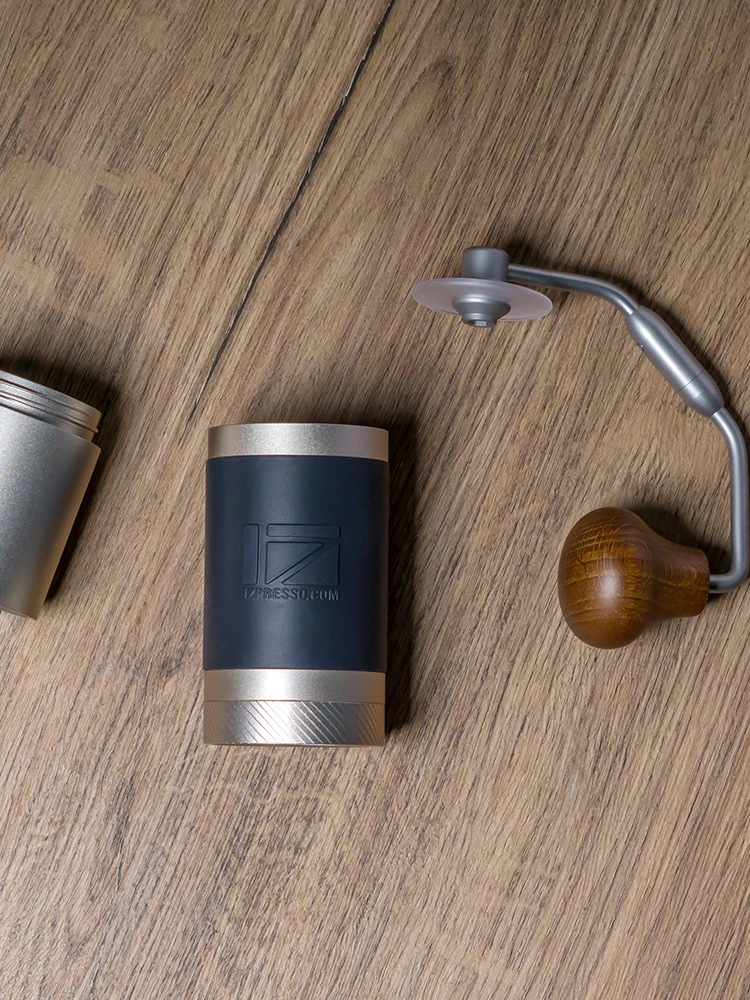
Practical Usability
Consider the ergonomics of grinding, as espresso requires significant effort compared to coarser grinds. Features like comfortable handles, good grip surfaces, and efficient grinding mechanisms can significantly improve the daily experience. Some models offer innovative handle designs that provide better leverage, reducing the physical effort required.
Capacity and Efficiency
Most manual grinders are designed for single-dose grinding, typically accommodating 20-30g of beans. For espresso, grinding efficiency becomes particularly important due to the fine setting and increased resistance. Higher-quality grinders can produce espresso grounds in 60-90 seconds, while less efficient models might take several minutes for the same amount.
Our collection of espresso coffee hand grinders features models specifically designed with these considerations in mind. When making your selection, prioritize adjustment precision and build quality, as these factors most directly impact your ability to achieve consistent, high-quality espresso extraction. Fine-tuning espresso grind size requires a grinder that can make the minute adjustments necessary for perfecting your shot.
Top Manual Grinders for Espresso: Detailed Analysis
Finding the right manual grinder for espresso can dramatically improve your brewing experience. Here’s an analysis of some top performers specifically capable of the precision grinding espresso demands:
Premium Performance Grinders
These top-tier manual grinders offer exceptional precision, consistency, and build quality ideal for dedicated espresso enthusiasts:
1Zpresso J-Series: Features premium steel burrs (48mm) with remarkable consistency and 222 micro-adjustment settings. The J-Max particularly excels for espresso with its fine adjustment capabilities and efficient grinding (60-90 seconds for a double shot). The solid construction eliminates burr wobble, ensuring consistent particle size distribution.
Kinu M47: Known for exceptional build quality and grind consistency. Its stepless adjustment mechanism offers infinite settings for precise dialing-in. Though requiring more investment, the machined hardened steel burrs and robust construction make it a lifetime purchase for many espresso lovers.
Comandante C40: Features specially designed high-nitrogen steel burrs producing remarkably consistent grounds. While primarily known for filter coffee excellence, with the addition of “Red Clix” adjustment assembly, it becomes highly capable for espresso use, offering double the standard number of adjustment points.
Mid-Range Excellence
Offering impressive performance at more accessible price points:
Timemore Chestnut Series: Models like the Slim Plus and C2 offer good espresso grinding capability with high-quality steel burrs and precise adjustment mechanisms. While requiring slightly more effort than premium options, they produce consistent results at a lower investment level.
Kingrinder K-Series: These grinders offer impressive value with their hardened steel burrs and precision adjustment systems. The K4 and K6 models are particularly well-suited for espresso, with numerous fine adjustment settings and stable grinding performance.
Entry-Level Options
More budget-friendly choices that can still produce workable espresso grinds:
- Normcore V2: Offers surprising performance for its price point, with decent adjustment range and stainless steel burrs capable of espresso fineness. While grinding takes longer (2-3 minutes for espresso), the results can be quite good with practice.
Fine Adjustment Hand Grinder, Precision Manual Grinder, Travel Coffee Grinder
Price range: $185.11 through $494.63 Select options This product has multiple variants. The options may be chosen on the product pageHand Burr Grinder, Hand Crank Coffee Grinder, Manual Espresso Grinder, Portable Coffee Grinder
Price range: $262.72 through $300.22 Select options This product has multiple variants. The options may be chosen on the product pageManual Burr Mill, Manual Coffee Grinder Stainless Steel, Manual Coffee Mill Grinder, Mechanical Coffee Grinder
Price range: $127.26 through $130.32 Select options This product has multiple variants. The options may be chosen on the product pageHand Burr Grinder, Manual Coffee Grinder Stainless Steel, Precision Manual Grinder
Price range: $183.64 through $187.52 Select options This product has multiple variants. The options may be chosen on the product page
When evaluating these options, consider your specific needs. If you’ll be preparing multiple espresso shots daily, the efficiency and consistency of premium models justify their cost. For occasional espresso preparation, mid-range options offer excellent value. All quality manual coffee grinders for espresso share the ability to produce the fine, consistent grind necessary for proper extraction, though they differ in ease of use, adjustment precision, and grinding efficiency.
The investment in a quality manual espresso grinder typically pays dividends in extraction quality, with many users reporting significant improvement in flavor complexity and consistency compared to pre-ground coffee or less capable grinders.
The Time and Effort Reality of Manual Grinding for Espresso
Manual espresso grinding requires a genuine time and physical commitment that prospective buyers should understand. Unlike grinding for filter coffee, producing espresso-fine grounds demands more effort and patience due to the significant resistance created by the fine burr setting.
On average, grinding a typical 18-20g dose for a double espresso takes between 1-3 minutes of continuous effort, depending on your grinder’s efficiency, burr size, and the specific beans being ground. Premium grinders with larger burrs (40mm+) and efficient cutting geometries typically reduce this time to 60-90 seconds, while smaller or less efficient grinders might require 2-3 minutes of sustained turning.
The physical effort shouldn’t be underestimated—espresso grinding creates substantial resistance that some users find challenging, particularly when preparing multiple shots. Several techniques can improve efficiency and reduce strain:
- Proper grip position: Hold the grinder firmly with your non-dominant hand while turning the handle with your dominant hand.
- Body mechanics: Keep your elbow close to your body while grinding to utilize stronger muscle groups.
- Shorter cranking motions: When resistance is high, shorter, more powerful turns are often easier than complete rotations.
- Bean preparation: Breaking beans into smaller pieces before grinding (a gentle pulse in a separate grinder or crushing with a flat object) can reduce initial resistance.
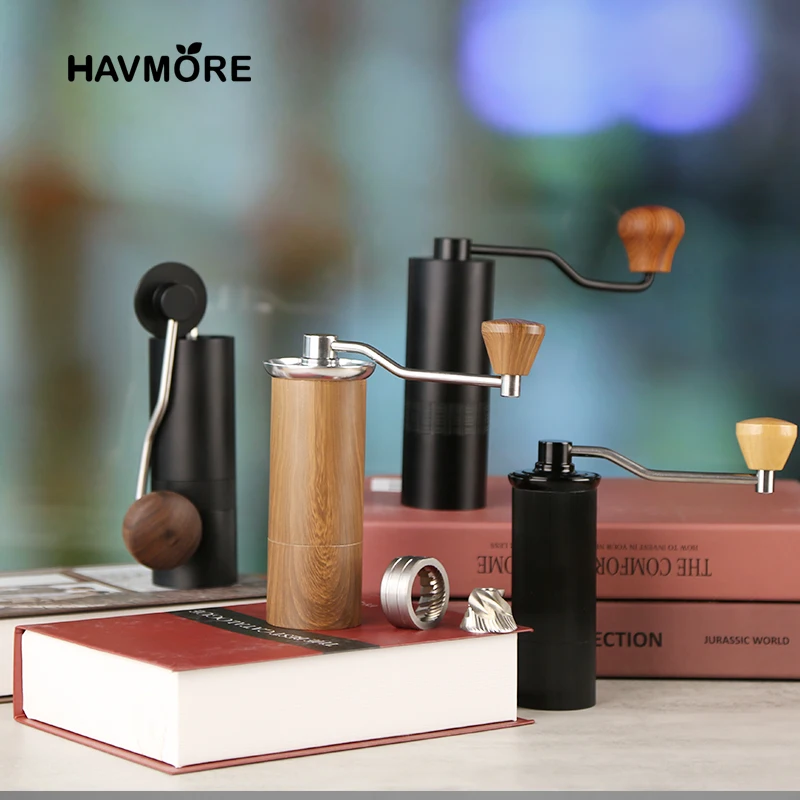
Different coffee varieties create different grinding experiences—dense, light-roasted beans typically require more effort than medium or dark roasts. High-grown, hard beans from regions like Ethiopia or Kenya often demand more grinding effort than lower-density beans from Brazil or Colombia.
Despite these demands, many enthusiasts find the manual grinding process meditative and satisfying. The direct connection to the brewing process and the superior freshness of just-ground coffee often justify the additional effort. Many users of manual burr mills report that the ritual becomes an enjoyable part of their coffee routine, with the physical effort contributing to the appreciation of the final result.
For those concerned about the time investment, consider that while electric grinders offer convenience, quality manual grinders often provide comparable or superior grind consistency at lower price points, making them an excellent value proposition despite requiring more physical input.
Optimizing Puck Preparation for Manual Espresso
Perfect grind size alone doesn’t guarantee excellent espresso—proper puck preparation transforms those grounds into an ideal medium for extraction. The goal is to create a perfectly level, evenly distributed puck with consistent density throughout, eliminating preferential pathways for water.
The distribution process begins immediately after grinding. First, ensure your grounds are free from clumps, which can create density variations. Many baristas use a technique called WDT (Weiss Distribution Technique), which involves gently stirring the grounds with a fine tool like a dissected paperclip or purpose-made distribution needle. This breaks up clumps and creates a homogeneous distribution.
After distributing, level the coffee bed before tamping. Various distribution tools can help achieve this, from simple tapping techniques to dedicated distribution tools that create a perfectly level surface. The key is achieving uniform density throughout the puck before applying pressure.
When tamping, apply approximately 30-40 pounds (13.6-18.1 kg) of pressure straight down on the coffee bed. The exact pressure is less important than consistency between shots. What matters most is creating a level tamp that’s perpendicular to the portafilter, preventing water from finding an easier path along one side.
The relationship between grind quality and puck preparation is synergistic. Even the most perfect grind will extract poorly with improper distribution, while excellent distribution can somewhat compensate for minor grind inconsistencies. Mastering espresso grind size works hand-in-hand with proper puck preparation technique.
Common signs of improper puck preparation include:
- Channeling (visible holes or jets in the extraction)
- Uneven extraction (one side extracts faster than the other)
- “Donut extractions” (center extracts more slowly than edges)
- Inconsistent shot times despite identical grind settings
By mastering both proper grinding and puck preparation, you create the conditions for consistent, high-quality extraction that showcases the coffee’s best qualities.
Advancing Your Manual Espresso Skills: Beyond Basic Grinding
As you become comfortable with the fundamentals of espresso grinding, several advanced techniques can elevate your manual espresso experience. Developing these skills helps you extract the most complex and satisfying flavors from your coffee beans.
Palate Development
Training your taste buds to detect subtle extraction differences is perhaps the most valuable advanced skill. Practice comparative tasting by preparing two shots with slightly different grind settings, noting how small adjustments affect sweetness, acidity, and mouthfeel. Keep a tasting journal to track your observations and grind adjustments, helping you build pattern recognition over time.
Temperature Management
Manual machines often lack the temperature stability of high-end electric models, but you can develop techniques to manage this variable. “Temperature surfing” involves timing your brewing relative to the heating cycle of your machine. For cooler extraction (ideal for darker roasts), pull shots shortly after the heating indicator turns off. For hotter extraction (better for light roasts), wait 10-15 seconds after the indicator signals readiness.
Pre-Infusion Techniques
Pre-infusion—applying low pressure to the coffee bed before full extraction—can dramatically improve shot quality, especially with manual machines. This initial gentle wetting helps prevent channeling and allows for slightly finer grinding without choking the machine. With lever machines, this might involve slowly raising the lever to begin water flow, then pausing briefly before completing the extraction.
Bean Adaptation
Different coffee origins and processing methods respond best to different grinding approaches. For example:
- Natural processed coffees often benefit from slightly coarser grinding due to their inherent sweetness and body
- Washed African coffees might require finer grinding to fully develop their complex acidity
- Dense, light-roasted beans typically need finer grinding than darker, more brittle beans
Grinder Maintenance
Consistent performance requires regular maintenance. Maintaining manual coffee grinders should become part of your routine—clean your burrs weekly for daily use, removing coffee oils and fine particles that can affect taste and consistency. Check burr alignment periodically, as even slight misalignment can create inconsistent particles and uneven extraction.
By continuously refining these advanced skills, you’ll extract nuanced flavors that showcase each coffee’s unique characteristics, transforming your manual espresso experience from good to exceptional.
Boolean Questions: Common Espresso Grinding Concerns
Can manual grinders really achieve espresso-level fineness?
Yes, quality manual grinders with precision burr sets can absolutely achieve the fineness required for espresso. However, not all manual grinders have this capability—look specifically for models marketed for espresso use with fine adjustment mechanisms.
Is hand grinding too inconsistent for good espresso?
No, high-quality manual grinders can produce grounds as consistent as many electric grinders. The consistency depends primarily on the quality of the burrs and the stability of the grinder’s construction, not whether it’s manually or electrically powered.
Do I need to adjust my grind for every new bag of beans?
Yes, different coffee beans require different grind settings due to variations in density, moisture content, roast level, and age. Even beans from the same roaster typically need slight adjustments between batches.
Should I single-dose for espresso grinding?
Yes, single-dose grinding (measuring your exact dose before grinding) is highly recommended for espresso. This approach ensures maximum freshness and allows you to make precise adjustments for each shot without wasting coffee.
Do manual grinders wear out quickly with espresso use?
Quality manual grinders with hardened steel burrs can maintain their performance for many years, even with regular espresso grinding. Ceramic burrs may wear more quickly but are still durable for home use. Regular cleaning and proper use significantly extend burr life.
Is grinding for espresso significantly harder than for other brewing methods?
Yes, the physical effort required for espresso grinding is notably higher than for coarser settings. The fine setting creates more resistance between the burrs, making turning the handle more demanding.
Do more expensive manual grinders perform better for espresso?
Generally yes, higher-priced manual grinders typically offer better performance for espresso due to more precise adjustment mechanisms, larger and higher-quality burrs, and more stable construction. However, there are diminishing returns beyond a certain price point.
Can I use the same grind setting for different manual espresso machines?
No, each manual espresso machine may require different grind settings due to variations in basket size, water distribution, and pressure characteristics. When changing machines, expect to dial in your grind again. Comparing manual and automatic espresso grinder settings shows similar principles apply across equipment types, though specific settings will vary.
The Relationship Between Coffee Bean Selection and Grind Requirements
The coffee beans you select significantly impact your grinding approach and ultimately your espresso quality. Understanding how different bean characteristics affect grinding can help you achieve more consistent and flavorful results.
Roast Level Considerations
Roast level is perhaps the most immediately noticeable factor affecting grinding requirements:
- Dark roasts are more brittle and soluble, typically requiring coarser grinding to prevent over-extraction and excessive bitterness. They also tend to grind more easily, requiring less physical effort.
- Light roasts are denser and less soluble, often needing finer grinding to extract their full flavor potential. They typically require more physical effort to grind due to their density.
- Medium roasts offer a middle ground, balancing solubility and extraction characteristics.
Origin and Density Factors
Coffee grown at higher elevations typically develops more density, affecting both grinding effort and extraction characteristics. For example:
- High-grown beans from Ethiopia, Kenya, or Colombia tend to be denser, requiring finer grinding and more effort
- Lower-grown beans from Brazil or Indonesia are typically less dense and may extract well with slightly coarser settings
Freshness Timeline
Coffee beans evolve significantly after roasting, directly affecting grinding requirements:
- Very fresh beans (1-7 days after roast) contain significant CO2 and may require slightly coarser grinding to account for degassing during extraction
- Beans in their prime (7-21 days after roast) typically provide the most stable grinding and extraction behavior
- Older beans (beyond 3-4 weeks) become increasingly dry and porous, often requiring progressively finer grinding to maintain proper extraction time

Processing Method Impact
How coffee is processed after harvesting influences its cellular structure and grinding needs:
- Natural (dry) processed coffees often have more oils and sugars near the surface, sometimes requiring slightly coarser grinding to prevent over-extraction of these compounds
- Washed coffees typically have more uniform density and moisture content, providing more predictable grinding and extraction behavior
- Honey and experimental processes may require experimentation to find optimal grinding parameters
Understanding beyond numbers perfect espresso grind means recognizing that optimal grinding is a dynamic relationship between your specific beans, your equipment, and your taste preferences. This awareness allows you to adapt your approach intentionally rather than treating grind size as a fixed parameter.
Pre-Infusion Techniques and Their Impact on Grind Size
Pre-infusion—the process of gently wetting coffee grounds at low pressure before full extraction—can significantly enhance espresso quality and allows for adjustments to your grinding approach. This technique is particularly valuable with manual espresso machines, where you have direct control over the extraction process.
During pre-infusion, water gradually saturates the coffee puck at low pressure (typically 1-3 bars) for 5-10 seconds before full extraction pressure is applied. This initial gentle wetting serves several critical functions:
- It allows the coffee grounds to swell uniformly, reducing the likelihood of channeling
- It helps dissolve some compounds before the main extraction, creating more balanced flavors
- It compensates for minor distribution imperfections in the coffee puck
For manual machines with direct lever control, pre-infusion typically involves slowly raising the lever to begin water flow, then holding it briefly at a point where water enters the coffee but full pressure isn’t applied. After this pause, the extraction continues with full lever pressure. Spring-lever machines often naturally provide some pre-infusion as the spring gradually builds pressure.
The relationship between pre-infusion and grind size is particularly interesting. When incorporating pre-infusion into your technique, you can often grind slightly finer than would otherwise be possible. This finer grind increases surface area for extraction while the pre-infusion helps prevent the puck from becoming too resistant to water flow.
This combination—pre-infusion with a slightly finer grind—often produces espresso with:
– Enhanced sweetness and reduced acidity
– More pronounced body and mouthfeel
– Better extraction of desirable aromatic compounds
– Reduced risk of channeling and uneven extraction
When experimenting with pre-infusion, start with your established grind setting, then gradually adjust finer while extending pre-infusion time as needed. The goal is to maintain approximately 25-30 seconds of total extraction time (including the pre-infusion phase), adjusting both variables to achieve balanced, complex flavors.
Maintaining Your Manual Grinder for Consistent Espresso Performance
Regular maintenance of your manual coffee grinder is essential for consistent espresso extraction. Even the finest grinder will gradually lose performance without proper care, affecting the uniformity of your grounds and ultimately your espresso quality.
Regular Cleaning Schedule
For espresso grinding, implement a maintenance routine based on your usage frequency:
– Weekly cleaning for daily use
– Bi-weekly cleaning for occasional use
– Deep cleaning monthly regardless of use frequency
Basic cleaning involves disassembling the grinder according to the manufacturer’s instructions and removing coffee residue from the burrs using a soft brush. For espresso grinders, pay special attention to the fine grounds that can become compacted in the burr teeth and adjustment mechanism.
Proper Cleaning Methods
When cleaning your grinder, follow these best practices:
– Use a dry brush rather than water for regular cleaning
– For deeper cleaning, specialized grinder cleaning products like Grindz can remove coffee oils without damaging burrs
– Avoid using water on steel burrs to prevent rust formation
– Allow all components to dry completely before reassembly
– Use compressed air (in short bursts) to remove stubborn particles from difficult-to-reach areas
Alignment and Calibration
Espresso grinding requires precise burr alignment for consistent particle size:
– Periodically check that your burrs are correctly aligned and not wobbling
– If your grinder has calibration capabilities, verify your zero point (where burrs just touch) regularly
– Listen for any unusual sounds during grinding that might indicate misalignment or foreign objects
Warning Signs of Grinder Issues
Be alert to these indicators that your grinder needs attention:
– Inconsistent grind size or visible particle size variation
– Unusual resistance or catching during grinding
– Metallic sounds that might indicate burr contact
– Declining flavor clarity in your espresso
– Inconsistent extraction times despite identical settings
Quality manual coffee burr grinders are designed for long-term use, with many capable of grinding thousands of pounds of coffee before requiring burr replacement. Investing time in proper maintenance protects your equipment investment and ensures consistent extraction quality over many years.
With regular care and occasional deep cleaning, your manual grinder will continue to produce the precise, consistent grounds necessary for exceptional espresso, making the maintenance effort well worth the few minutes it requires.

